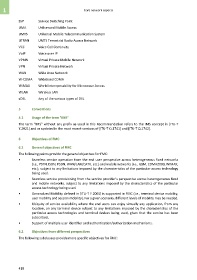Page 428 - 5G Basics - Core Network Aspects
P. 428
1 Core network aspects
SSP Service Switching Point
UMA Unlicensed Mobile Access
UMTS Universal Mobile Telecommunication System
UTRAN UMTS Terrestrial Radio Access Network
VCC Voice Call Continuity
VoIP Voice over IP
VPMN Virtual Private Mobile Network
VPN Virtual Private Network
WAN Wide Area Network
W-CDMA Wideband CDMA
WiMAX World Interoperability for Microwave Access
WLAN Wireless LAN
xDSL Any of the various types of DSL
5 Conventions
5.1 Usage of the term "IMS"
The term "IMS" without any prefix as used in this Recommendation refers to the IMS concept in [ITU-T
Y.2021] and as updated in the most recent versions of [ITU-T Q.1741] and [ITU-T Q.1742].
6 Objectives of FMC
6.1 General objectives of FMC
The following points provide the general objectives for FMC:
• Seamless service operation from the end user perspective across heterogeneous fixed networks
(i.e., PSTN, ISDN, PSDN, WAN/LAN/CATV, etc.) and mobile networks (i.e., GSM, CDMA2000, WiMAX,
etc.), subject to any limitations imposed by the characteristics of the particular access technology
being used.
• Seamless service provisioning from the service provider's perspective across heterogeneous fixed
and mobile networks, subject to any limitations imposed by the characteristics of the particular
access technology being used.
• Generalized Mobility defined in [ITU-T Y.2001] is supported in FMC (i.e., terminal device mobility,
user mobility and session mobility). For a given scenario, different levels of mobility may be needed.
• Ubiquity of service availability where the end users can enjoy virtually any application, from any
location, on any terminal device subject to any limitations imposed by the characteristics of the
particular access technologies and terminal devices being used, given that the service has been
subscribed.
• Support of multiple user identifier and authentication/authorization mechanisms.
6.2 Objectives from different perspectives
The following subclauses provide more specific objectives for FMC:
418

